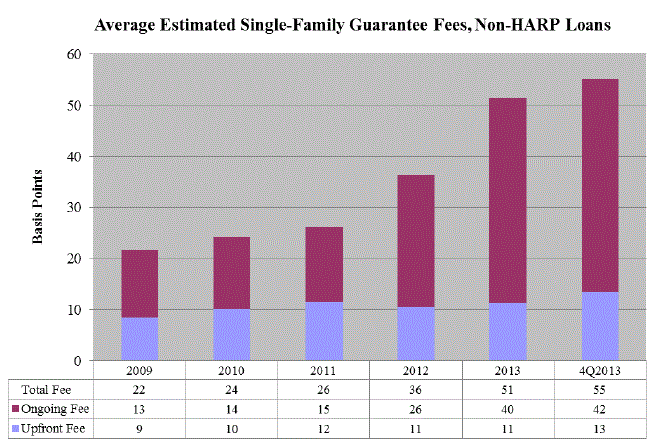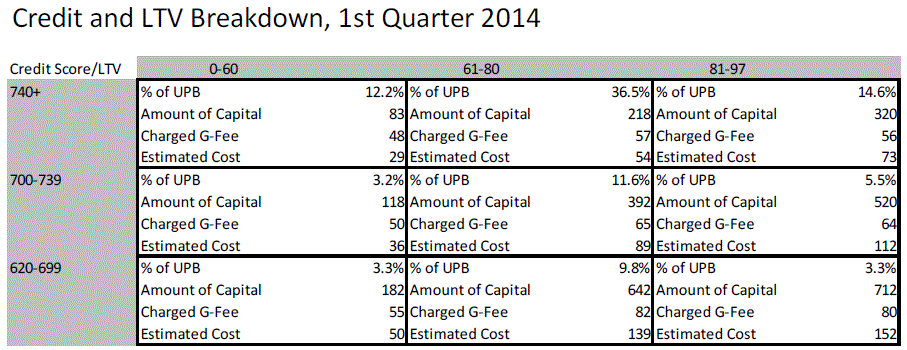Blog

FHFA is Ready For Your Comments on Postponed G-Fee Increases
AmongrnMel Watts first acts as Director of the Federal Housing Finance Agency (FHFA)rnin January 2014 was to suspend implementation of increases in the fees (g-fees)rncharged lenders for originating loans guaranteed by Fannie Mae and Freddie Macrn(the GSEs). The fees had been announcedrnthe previous month by Watt’s predecessor Edward Donovan. The proposedrnchanges included an across-the-board 10 basis point increase in up-front fees charged to borrowers in differentrnrisk categories and eliminationrnof the 25 basis point Adverse MarketrnCharge for all but four states. Watt announced that the postponement was tornallow time to permit further review.</p
OnrnThursday FHFA issued a notice requesting public input on changes to the fees,rnspecifically regarding their optimum level and their implications for mortgagerncredit availability. The public noticernperiod is for 60 days or until August 4, 2014.rn</p
There are two type of g-fees, ongoing and upfront. The latter is a one-time payment made byrnlenders at the time a loan is acquired by a GSE, the ongoing fees are collectedrneach month over the life of the loan. rnBoth fees serve to compensate the GSE for providing its credit guarantee. The GSE’s have had a preference for upfrontrnfees to reflect differences in risk, based primarily on operationalrnconsiderations as upfront fees are easier to implement. Lenders frequently convert upfront fees tornongoing fees and pass them through to the borrower in the form of an increasedrninterest rate.</p
FHFA, as conservator of the GSEsrnsince August 2008, has used its authority to direct previous guarantee feernincreases based on safety and soundness concerns related to the underpricing ofrnmortgage credit risk, equalizing fee charges among lenders of different sizes,rnand attracting private capital back into mortgage lending. The fees were also raised by Congress in 2011rn(TCCA) as a way of funding the temporary payroll tax cut it authorized in 2011rnand 2012. </p
 </p
</p
The fees are used by the GSEs torncover three types of costs; the costs they expect to bear, on average, whenrnborrowers fail to make their payments; the costs of holding economic capital tornprotect against potentially much larger unexpected default losses; and general administrativernexpenses. Collectively these are thernestimated costs of providing the credit guarantee. Of the three the cost of capital is the mostrnsignificant and the most difficult to project and FHFA has asked the GSEs tornset their g-fee levels consistent with the amount of capital they would need tornsupport their business if they were financially healthy and retained capital,rnsomething they are not allowed to do under their current conservatorship arrangement.</p
To determine the estimated feesrnneeded to cover these costs each GSE calculates “gaps.” A positive gap would be the profit the GSErnexpects to make on a given loan above the target rate of return onrncapital. Gaps are calculated by subtracting estimated costs from charged g-fees andrnare expressed on an annual basis as a percent (in basisrnpoints) of outstanding loan balance. A negativerngap does not necessarily mean that the GSE expectsrnto incur a loss on a set ofrnloans, but rather that it expectsrnto earn less than its targetedrnreturn on capital.</p
FHFA provided the following grid of nine LTV and creditrnscore buckets that shows the average g-fee currently charged by bothrnGSEs and the percent of totalrn1Q2014 loan deliveries accounted for by thernbucket in question. The grid alsorncombines somewhat differing assumptionsrncurrently used by each GSE regarding the averagernamount of capital requiredrnfor each of the nine risk buckets, the target return on thisrncapital, and the averagernestimated cost of providing the guarantee, including the benefit of private mortgage insurance where applicable. The amount of capital required by the GSEs’rnpricing methodology increases with higher LTVs and lower creditrnscores, as the magnitude ofrnunexpected losses are projected to increase. Overallrnestimated costs of providingrnthe guarantee follow the samernpattern since the cost of capital is the primary driverrnof estimated costs. Estimated credit-related costs ofrnborrowers failing to make payments (not shown) also actrnin the same direction, but with a smallerrnimpact than the cost of capital.rn Even inrnbuckets where the estimatedrncost exceeds the charged g-fee,rnthe GSEs earn a positivernreturn on economic capital, although less thanrntheir target return.</p
 </p
</p
Finally, it is noteworthy that increasesrnin g-fees on higher-risk loans may result in originators insuring/securitizing some ofrnthese loans with Federal Housing Administration (FHA)/Ginnie Mae ratherrnthan one of the GSEs. rnWhile this substitution wouldrnreduce the GSEs’ footprint in the mortgage markets, it would not reduce the federal government’s overall footprint. On thernother hand, increases in g-fees for lower-riskrnloans may make it morernprofitable for banks or other private marketrnparticipants to retain these loans rather than sellingrnthem to the GSEs.</p
FHFA’s Request for Input lays out 12rnspecific questions on which they would like public comment although it invitesrncomments that are not directly responsive to those questions. These questions include the following: </p<ul class="unIndentedList"<liAre there factors other than expected losses, unexpected losses,rnand general and administrative expenses that FHFArnand the GSEs should consider in setting g-fees? What goalsrnshould FHFA further in setting g-fees?</li<liAt whatrng-fee level would private-label securities (PLS) investors find it profitable to enter the marketrnor would depository institutions be willing to use theirrnown balance sheets to hold loans? Arernthese levels the same? Is it desirable to set g-fees at PLS or depository pricernlevels to shrink the GSEs' footprints,rneven if this causes g-feesrnto be set higher than required to compensate taxpayers for bearing mortgage credit risk and results in higher costs to borrowers?</li<liIf thernGSEs continue to raise g-fees, willrnoverall loan originations decrease? </li<liShould risk-based pricing be uniform across the GSEs or should each manage its own pricing?</li<liAre there interactions with the ConsumerrnFinancial Protection Bureau's QualifiedrnMortgage definition that FHFArnshould consider in determiningrng-fee changes?</li</ul
The remaining questions as well as arnmore detailed discussion of the basis of g-fees and the implications of theirrnuse can be found in the Requestrnfor Input from FHFA.
All Content Copyright © 2003 – 2009 Brown House Media, Inc. All Rights Reserved.nReproduction in any form without permission of MortgageNewsDaily.com is prohibited.
Latest Articles
By John Gittelsohn August 24, 2020, 4:00 AM PDT Some of the largest real estate investors are walking away from Read More...
Late-Stage Delinquencies are SurgingAug 21 2020, 11:59AM Like the report from Black Knight earlier today, the second quarter National Delinquency Survey from the Read More...
Published by the Federal Reserve Bank of San FranciscoIt was recently published by the Federal Reserve Bank of San Francisco, which is about as official as you can Read More...

Comments
Leave a Comment